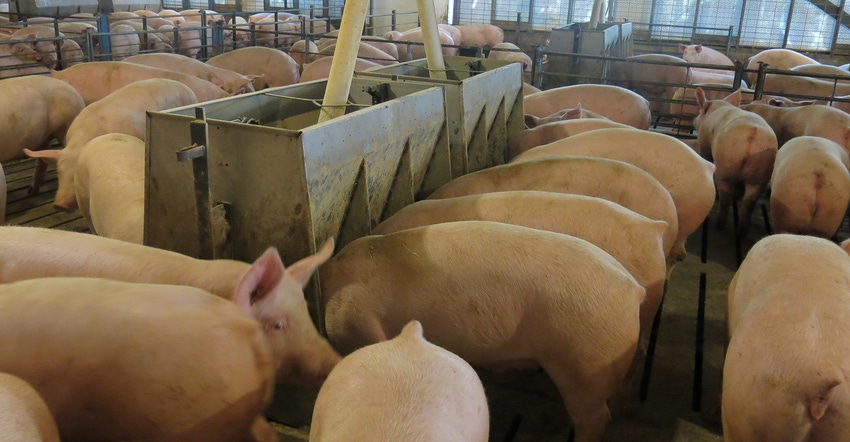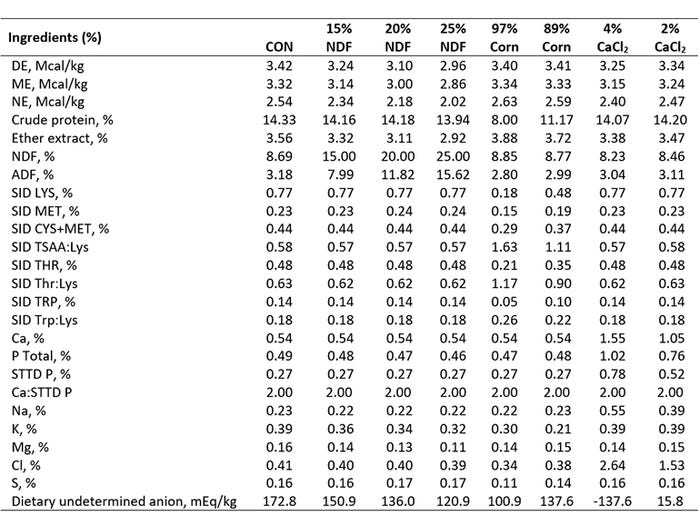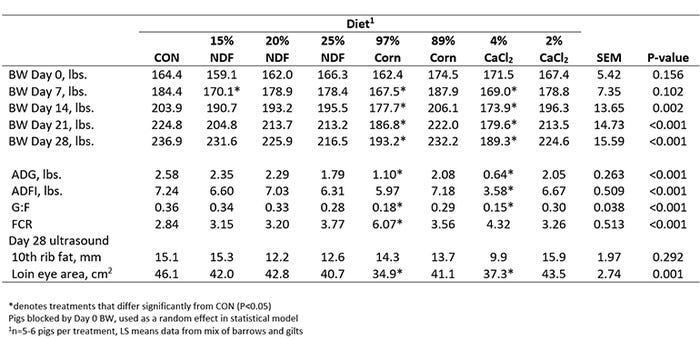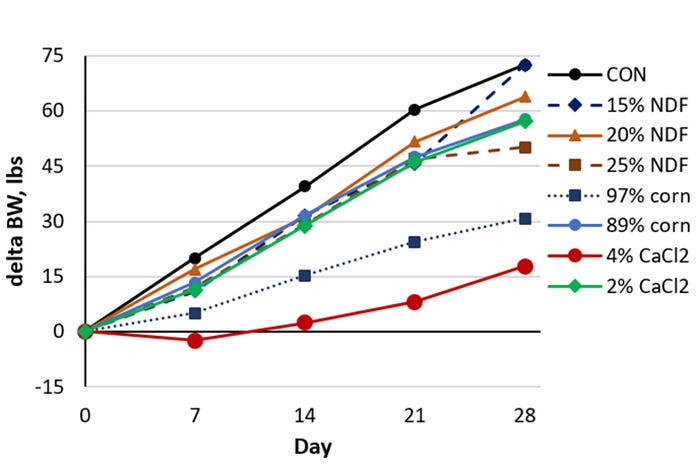Impact of these diet strategies on pig behavior, potential for negative vices during group housing, and the effect on carcass and pork quality need to be determined.
May 12, 2020

In recent weeks, the COVID-19 pandemic has created massive direct and indirect fall-out for U.S. pork producers. Primarily, this has been a consequence of supply chain disruptions and the loss of packing plant capacity. As such, producers are having to adjust pig flows and growth of finishing pigs to accommodate altered marketing strategies. Typically, producers aim to optimize grow-finish pig growth rates and feed intake to maximize pig performance and profitability.
However, the current supply chain issues are requiring producers to slow growth rates and/or reduce feed intake. Although this is specific to COVID-19, other situations could occur in the future. These scenarios could include response to feed supply interruptions for an extended period of time and also when the movement of animals to market is delayed or impaired due to an animal movement standstill, such as could occur during a suspected outbreak of a foreign animal disease, or in situations when access to harvest facilities is temporarily suspended or delayed.
In lieu of the current predicament of reduced capacity, slowing or holding pig growth, many articles have been written but lack clear empirical evidence of what may work with today's lean, high-growth-rate genetics. Thus, data, tools and support are immediately needed by the pork production and packing industries to address the logistical, economic and management scenarios currently brought about by the COVID-19 pandemic. Importantly, this information can be used for potential future supply chain issues.
To address the surprising lack of reliable and science-based information available to the industry on the use of nutrition to attenuate finishing pig growth performance, our team has responded to produce such data in a timely manner. In late-March, we started a project with the objective of evaluating three different options involving alternative dietary formulations to slow pig growth rates and reduce feed intake. Preliminary results of this small body of work are presented herein.
To address our study objective, 46 barrows and gilts (166 ±13.5 pounds bodyweight; Camborough (1050) X 337) were blocked by body weight and sex, individually penned and assigned to one of eight dietary treatments (n=5-6 pigs per treatment). The dietary treatments included:
Control diet (CON)
15% Neutral detergent fiber (15% NDF)
20% Neutral detergent fiber (20% NDF)
25% Neutral detergent fiber (25% NDF)
No Soybean meal (97% Corn)
Half soybean meal of No. 1 (89% Corn)
Anhydrous calcium chloride 4% (4% CaCl2)
Anhydrous calcium chloride 2% (2% CaCl2)
These eight dietary treatments are detailed in Tables 1 and 2. The CON diet was formulated as a traditional corn-soybean meal diet that met or exceeded National Research Council (2012) nutrient requirements for this size finishing pig and is consistent with a commercial production diet. These dietary treatments represent three experimental approaches to slow finishing pig growth rates. The first approach increased NDF content of the diets from approximately 8.5% (CON) to 15%, 20% and 25% by increasing the inclusion rate of soy hulls (12.5-33.2% of diet in diets 2-4, respectively). Amino acids were kept the same as the CON, but dietary ME was allowed to float downwards as dietary fiber increased.


The second approach simply and practically tested the effects of reducing dietary essential amino acid concentrations (treatments 5 and 6). This was achieved crudely by the complete or 50% removal of soybean meal from the CON diet formulation and adding this quantity back as corn. Thus, diet 5 was 97% corn and diet 6 consisted of 89% corn. Both these diets, ME, vitamins and minerals were formulated to be the same as the CON diet. Amino acid ratios were allowed to float in order to antagonize efficient use of essential amino acids for lean growth.
The third and final diet formulation approach was the most technically challenging and involved increased concentration of an acidogenic salt (dietary treatments 7 and 8). These two diets explored the effects of calcium chloride, an acidogenic salt and is known to reduce feed intake. These diets were formulated to contain 4% and 2% anhydrous calcium chloride. This resulted in a six- and three-fold increase in chloride, respectively from the CON diet. Nutritionists use an equation called dietary undetermined anion or dUA to formulate such diets. For those interested, the equation looks like this:
dUA (mEq/kg) = (Na+1 + K+1 + Ca+2 + Mg+2) + (Cl-1 + P-1.8 + Sinorganic)-2).
The calculation, carried out in mEq/kg, is really counting charges from each electrolyte and that is why the valence (charge) is used in the equation. Note that the sulfur in sulfur amino acids is not included in the equation. Briefly, metabolism in any animal tends to generate acid which it eliminates from the body through respiration and urination. But the diet plays a role, too. When dUA is numerically high, it tends to help the pig deal with this acid load from metabolism. But as dUA declines, it provides less assistance to the pig to handle the acid load. When the acid load reaches a certain level, feed intake declines. Adding calcium chloride to the diet lowers dUA and in this manner, discourages feed intake in the pig.
Further study is required with this option, especially as it relates to feeding for more than three or four weeks.
In the above study, we kept the calcium to available phosphorus ratio constant across all treatments. This greatly adds to the cost of the diet, due to the high cost of phosphorus. We believe we can substantially reduce the amount of added phosphorus and thus lower the cost of this option. A study is currently underway to help us answer this question.
All pigs were ad libitum fed and had free access to water at all times. This was important, especially in the calcium chloride diets. Over a 28-day test period, pig body weights and feed disappearance were recorded and feed efficiency (G:F and F:G) calculated. On Day 28, all pigs were ultrasound scanned for determination of backfat depth and muscle loin eye area. All data were analyzed statistically (SAS Institute Inc., Cary, N.C.) with pen considered the experimental unit and block used as a random effect. Least square means of treatment (diet) were determined using the LS means statement and differences in LS means were produced using the pdiff option. All data are reported as LS means with a pooled SEM. Differences were considered significant when P ≤ 0.05 and a tendency when P ≤ 0.10.
Over this 28-day test period, one pig was removed from the 15% NDF diet due to health reasons. In Week 4, all pigs were placed on sodium salicylate due to an outbreak of swine influenza virus. The LS means data examining the effectiveness of our three key dietary approaches to reduce growth performance are shown in Table 3 and Figure 1. Although highly variable week to week, increasing the NDF content of the diets from 15 to 25%, were only marginally effective in reducing average daily gain and average daily feed intake in pigs compared to the CON pigs.


In the second strategy, soybean meal was replaced with corn. This resulted in dietary amino acids being lower than requirement for optimal lean growth. Consequently, the 97% corn diet significantly reduced ADG by 57% over the 28-day period compared to CON (P < 0.05). The 88% corn diet was intermediate with growth rates reduced 19% compared to CON pigs over 28 days (P > 0.05). In this strategy, pigs gained 30 and 57 pounds body weight on the 97% corn and 89% corn diets, respectively, compared to the CON pigs' 73 pounds body weight gain (Figure 1). Compared to the CON pigs ADFI, the ADFI of the two corn dietary treatments were not statistically different (P > 0.05).
The final strategy assessed the use of anhydrous calcium chloride. In the present study, anhydrous calcium chloride added at 4% and 2%, decreased dietary undetermined anion concentrations (see above) compared to the CON diet (-138, 15.8, and 173 mEq/kg, respectively; Table 2). As a result, only the 4% calcium chloride diet reduced ADFI by CON pigs (Table 3). However, only the 4% calcium chloride diet significantly reduced ADFI by 51% CON pigs (P < 0.05). This reduction in ADFI translated into a 75% reduction in ADG and pigs only gaining approximately 16 pounds body weight over the 28-day test period (P < 0.05). Although not significant, the 2% calcium chloride diet reduced growth rates by 21% compared to the CON (P > 0.05).
Uncertainty remains as to how dietary strategies to reduce finishing pig growth rates may impact carcass and pork quality. In particular, feeding high corn diets could promote excessive adipose tissue deposition that would result in packing grid penalties. Further, the impact of high calcium chloride diets on pork quality is largely unknown. Would these diets alter muscle post-mortem metabolism and color or increase the incidence of pale, soft, exudative pork? These questions need further evaluation.
To address how our diets might influence carcass characteristics, on Day 28 we ultrasound scanned all pigs for determination of backfat and loin eye area. Surprisingly, no differences in backfat were reported between dietary treatments (P = 0.292, Table 3). However, the 97% corn and 4% calcium chloride diets significantly reduced loin eye area by approximately 24% compared to the CON pigs (P = 0.001, Table 3). This reduction in loin eye area is most likely reflective of the decreased growth rates and lean accretion. These ultrasound data, although small in number of observations, suggest only moderate impact of these growth rate intervention diets on body carcass composition.
In conclusion, this small dataset aims to provide producers and allied industry with information on what is possible in reducing growth rates in finishing pigs. We express caution with this dataset as it is an ongoing study with small numbers of pigs per treatment. Pigs may metabolically adapt to their respective diets over time or pigs may behave differently during group pen situations. The impact of these three diet strategies on pig behavior, potential for negative vices during group housing, and the effect on carcass and pork quality need to be determined. However, the key take home points for this body of work are:
4% calcium chloride diet did the best at slowing pig growth rates over 28 days (approximately 16 pounds body weight gain) but it tends to be a more expensive option. The net cost will be determined by the balance between higher feed cost per pound compared to lower daily feed intake.
97% corn diet was successful at reducing growth rates over 28 days (approximately 30 pounds body weight gain). It is the simplest and least expensive dietary option.
Increasing the NDF content of diets marginally reduced body weight gains. Fiber sources can be expensive and currently are in short supply.
Economics of diets and feed intakes need consideration. Corn-base diet is cheaper than calcium chloride diets.
Additional information regarding nutritional strategies to regulate growth performance of market pigs can be found on our website. This project was funded by the Iowa Pork Industry Center Rapid Research Fund and by the authors. Anhydrous calcium chloride was donated by Nutra Blend (Neosho, Mo.).
Sources: Nicholas Gabler, John Patience, Laura Greiner and Jason Rossa, who are solely responsible for the information provided, and wholly own the information. Informa Business Media and all its subsidiaries are not responsible for any of the content contained in this information asset.
You May Also Like



